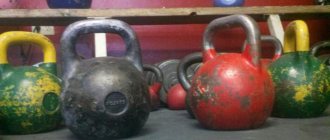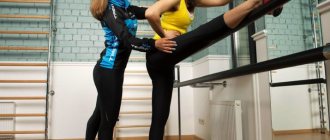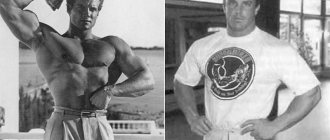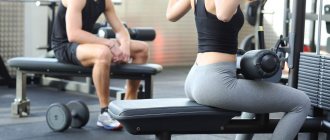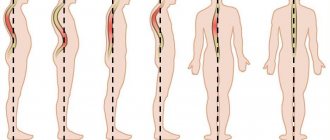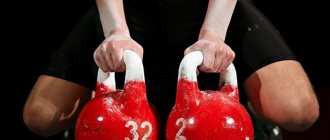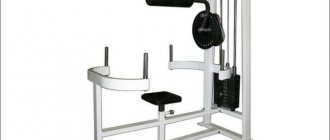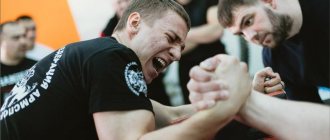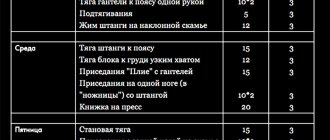Kettlebell training programs will invigorate you like nothing else. Powerful complexes from kettlebell masters Pavel Tsatsouline and Sergei Rudnev can take you to a new level and pump up your body.
You need to be very advanced in terms of pumping muscles with weights to understand the beauty of kettlebell lifting. However, you should try different options before drawing any conclusions. You know, this is a very exciting and intriguing activity!
The training program will be presented in 2 versions:
- from Pavel Tsatsouline, Master of Sports of the USSR, physical training instructor for Soviet special forces, popularizer of kettlebell training in the USA, author of books.
- from Sergei Rudnev, MSMK, five-time World champion in kettlebell lifting, president of the international academy of kettlebell lifting and fitness.
Learn from the best, they are always ready to instruct you in this sport. After all, kettlebell exercises are exercises and training programs that can not only increase your muscle mass, they will make your body more resilient and strong.
Training program from Pavel Tsatsouline
Kettlebell training is something. The number of movements with weights significantly exceeds other equipment: dumbbells, exercise machines, free weights.
Their design involves a number of interesting exercises. The kettlebell combines cardio and strength training into a powerful combination. It's a rhythmic element that does wonders for your body balance and really raises your heart rate above anything else. Plus, just 10-15 minutes with weights and you'll tear yourself apart.
Most of Pavel's videos are currently only available in English, however they give an excellent overview of the movement techniques.
This complex is performed with two weights. According to the author, the program will force you to discover your body in a new way, and build muscle mass in the process.
Kettlebells for beginners
The initial stage is to get acquainted with this training. Only after training and learning the rules should you go to training. It’s good to know that kettlebell training is suitable for both men and women .
Kettlebell training rules for beginners
load
Choose the right load for both your weight/height and your abilities. It is better not to immediately take on heavy loads. It will be much better to start with smaller ones .
technique
You should read the beginner exercises carefully.
- At the gym – if in doubt, ask the trainer/instructor.
- If we train at home, it is best to carefully familiarize ourselves with the technique of the materials available on the Internet.
warm-up
Be sure to warm up beforehand to prepare your muscles for exercise.
breath
Remember to keep your breathing correct during your workout.
Program from Pavel Tsapulin - A
Circular - 9 circles
Hanging weight lifts
- 1 set x 1 rep
- Body part: Shoulders Equipment: Kettlebells
Military two-hand kettlebell press
- 1 set of 1-2-3-4-5-4-3-2-1 reps
- Body part: Shoulders Equipment: Kettlebells
Deep squats with kettlebells
- 1 set x 1 rep
- Body part: Quadriceps Equipment: Kettlebells
Kettlebell row while lying down
- 1 set x 1 rep
- Body Part: Middle Back Equipment: Kettlebells
Russian kettlebell swings
- 5 sets of 20 reps
- Body part: Hamstrings Equipment: Kettlebells
Add to Calendar * Add to My Workouts * Print Workout
* — The service is in beta testing
In the pyramid press, we go as high as possible to find the number of repetitions beyond which you simply cannot press.
On Wednesday we return to our training, but this time we perform squats using a “pyramid”:
Story
Until the late 40s of the 20th century, kettlebell lifting in the modern sense, as a competition in strength endurance, did not exist. Although the weights themselves as sports equipment have been known since the end of the 17th century. Kettlebells, along with barbells and dumbbells, were used to develop physical strength or in circus performances.
On October 24, 1948, under the patronage of weightlifting specialists, the first competitions were held in which athletes exercised with two-pound weights. Although there were no official rules yet, such competitions began to be held on an ongoing basis and weightlifters saw them as a way to attract the masses to their sport.
In 1962, the first rules for kettlebell lifting competitions were developed. Since the 70s, meetings between USSR athletes have been held on an ongoing basis, and sport has also been cultivated in the Armed Forces. During that period, the rules of kettlebell lifting were constantly changing towards simplification in order to involve ever wider layers.
If bodybuilding in the USSR was not encouraged due to the fact that it took resources away from weightlifting, then kettlebell lifting was strongly approved. The only obstacle to the official recognition of this sport as an independent one was the lack of constant rules - even during one season, competitions could be held according to different rules.
Variants of the rules using the example of a jerk:
— the jerk was performed with only one hand (either) or each hand;
— it was forbidden/allowed to touch any part of the body with the weights;
— the change of hands in the snatch was carried out through a swing or through a kettlebell somersault;
— scoring was carried out either by a simple sum of both hands, or by doubling the weak hand;
— time limit in the hanging position, etc.
In 1985, kettlebell lifting received official recognition, and in 1987, the All-Union Kettlebell Lifting Federation of the USSR was created. On October 29, 1992, it was dissolved and in its place the International Kettlebell Lifting Federation was created.
Program from Pavel Tsapulin - B
Circular - 11 circles
Hanging weight lifts
- 1 set x 1 rep
- Body part: Shoulders Equipment: Kettlebells
Military two-hand kettlebell press
- 1 set x 1 rep
- Body part: Shoulders Equipment: Kettlebells
Deep squats with kettlebells
- 1 set of 1-2-3-4-5-6-5-4-3-2-1 reps
- Body part: Quadriceps Equipment: Kettlebells
Kettlebell row while lying down
- 1 set x 1 rep
- Body Part: Middle Back Equipment: Kettlebells
One-arm kettlebell snatch
- 5 minutes 1 set
- Body part: Shoulders Equipment: Kettlebells
Add to Calendar * Add to My Workouts * Print Workout
* — The service is in beta testing
Do as many maximum repetitions of pyramid squats as you can handle. And aim to do a 5 minute dash. You can change your hand, for example, every 10 times.
It is recommended to take the weight for the snatch less than the working one. Exactly the kind that will allow you to make jerks for a long time. If at first you don’t succeed in five minutes, don’t give up.
Training schedule
Train on Mondays, Wednesdays and Fridays, changing the order of the bench press and squat pyramid:
| Week 1, 3 | Week 2, 4 |
| Monday – A/press (X) Wednesday – B/squats (Y) Friday – A/press (X) | Monday – B/squats (Y) Wednesday – A/press (X) Friday – B/squats (Y) |
You will perform the same number of MAXIMUM reps (X and Y) to “fix” the pyramids for 4 weeks. In the example workouts, these are 5 presses and 6 squats.
A new minimum program for Russian kettlebell lifting. Summary[edit | edit code]
- Twice a week, alternate between swinging and jogging for 12 minutes.
- Don't overexert yourself. Only put yourself out there when you're ready.
- The purpose of running is to relieve muscle tension and remove lactic acid. Running is an active recreation.
- Twice a week, perform Turkish get-ups for 5 minutes, alternating hands.
- Focus on technique, not quantity. Don't count repetitions or increase their number.
- Approximate plan for the week: Monday, Thursday - swings; Tuesday, Friday - Turkish rises. Or Monday, Thursday - Turkish rises; Tuesday, Friday - swing. You can add a day for swings or Turkish get-ups.
- Pre-workout: 10 minutes of wall-facing squats, halo, and swings. See details.
- If you are still an inexperienced athlete, do not lift weights on your free days and read the article Kettlebell Training: Basics of Technique.
Bodymaster.ru recommends Fitness Trainers:
In the fifth week we increase the MAXIMUM by +1 (total 6 and 7)
In the sixth week we increase the MAXIMUM by +2 from the base (total 7 and 8).
| Week 5 | Week 6 |
| Monday – A/press (X+1) Wednesday – B / squats (Y+1) Friday – A/press (X+1) | Monday – B / squats (Y+2) Wednesday – A/press (X+2) Friday – B / squats (Y+2) |
That's all. In six weeks, you will see your own gains in meat, and you will also feel your body in a new way. Unload yourself with a week of fun and easy training and you are ready for strength training that uses the “pyramid” (1, 2, 3, 2, 1).
These six-week workouts can be scheduled several times a year. Remember that you need to eat a good and balanced diet in order to gain quality mass.
Rest
You can rest between approaches as much as you see fit. A good guideline is restoring breathing. Rest one day between workouts.
Training plan for deadlifts[edit | edit code]
On a draw day, roll the dice to determine the length of the round, from 2 to 12 minutes.
- Monday - light jerks. About 50-60% of what you could do if you went all out.
- Wednesday - medium swings. About 7080% of what you could do if you went all out.
- Friday (hard day) - heavy swings. Give your all in the allotted time.
You are challenged - move on to a heavier kettlebell.
Considering that the snatch is one of the goals, you may find it strange that it is performed only once a week and also in an easy mode. This is done for two reasons. First, your shoulders and elbows in your first year of kettlebell training are not prepared for a lot of jerking. Don't worry, light snatches plus heavy swings and presses add up to a load equal to the snatches on test day. Second, the Rite of Passage program involves a lot of pressing, and by the time you get to the rows, your shoulders will already be getting the load they need. And the snatch, as you may have noticed, depends heavily on the shoulders. Therefore, you will not only do snatches at half effort, but also after a light bench workout. If, even on an easy day, you notice that your snatch technique is deteriorating, end your workout by replacing snatches with high rows.
Sets and reps[edit | edit code]
And now, with the help of Anthony Diluglio, a master of Russian kettlebell lifting, let’s apply the boxing term “rounds” to kettlebells. Russian elite weightlifters measure workouts in minutes, not sets and reps. Anthony Diluglio and Steve Maxwell focus their gyms on time rather than sets and reps. People of different training levels can choose different training options without any problems. A beginner can do 50 snatches with a 16kg kettlebell in 5 minutes and be exhausted. Mutant Steve Cotter, a master of Russian kettlebell lifting, does 110 repetitions with a 32-kilogram kettlebell during the same time, and also gets tired: “Very intense, your legs give way, and your heart is pounding in your chest.”
Working against the clock allows you to get off the hook for sets and reps. Here's what Steve Kotter says: “30/30 rest, 10/10 rest, 10/10 rest, 6/4 time up. A total of 110 repetitions in 5 minutes. When I rest, I place the kettlebell on the ground. After the first approach I rest for only 15 seconds, after subsequent approaches - a little longer. My strategy is to do at least 60% of the planned number of repetitions in the first 2 minutes of the test. If I can get 80 reps under 3:30-3:45, I know I can do 100 reps, which I consider baseline for my current fitness level. For progressive overload, I will try to perform more reps in the first 2 minutes. Next time I'll do 32/32 and 12/12 in the first two sets, and then stay the same for the rest."
Through trial and error you will find your pace. Don't worry about the ideal rhythm of work and rest. Even experienced athletes do not always manage to maintain the golden mean. Russian kettlebell master Katherine Imes did 94 reps with a 24kg kettlebell in 5 minutes, an achievement many men would envy. However, Katherine was unhappy with herself: “20/20, 12/12, 10/10, 5/5... I probably could have done more reps on the first set, but I finished it too quickly - it took me about 1 minute . And I rested too long between the 10/10 and 5/5 sets. Next time I'll do more than 100 reps."
Russian kettlebell master Jared Savik, who performs 275 reps, advises: “Do quick sets of 10-20 reps, resting when needed.”
When resting between approaches, you should not slouch or rest your hands on your knees. New Zealander Robin McKenzie explains: “During loading, the joints of the spine are subjected to stretching, loosening effects, and structural damage occurs in them. After significant stress, the joints of the spine are easily susceptible to adverse changes if you hunch over while resting.”
McKenzie gives an example of how vulnerable a slouched and warmed-up athlete is. The long-distance runner “was so exhausted from the hard running that when he finished the race, he hunched over with his back hunched and his hands on his knees. He remained in this position for about two minutes, after which he felt pain in his back, which did not disappear even after he straightened up.” The runner "couldn't walk because of the pain in his back... and naturally he assumed that the pain was caused by running." As Rob Lawrence, a master of Russian kettlebell lifting, would say: “It’s your own fault.”
After performing deadlifts, do five to six backbends. Place your hands on your lower back, fingers pointing down, and bend back, using your hands as a fulcrum. Return to an upright position. With each subsequent repetition, try to bend a little more. Between snatch or swing sets, it's helpful to do some light exercises like shadow boxing.
But why roll the dice and rely on a random number from 2 to 12? Russian science of periodization teaches that an athlete should practice one exercise without changes for a certain period of time, and the load, intensity, volume should change from workout to workout. Effective training is “the same, but different.” The working exercises remain the same, but their intensity and volume are always different. Oleg Chelishchev, a Russian kettlebell lifting coach, emphasizes: “The workload should fluctuate like a sea wave, up and down, from a mirror-like surface to a storm.” The dice provide this opportunity: a two is smooth, two sixes are a storm.
Just from 2 to 12 minutes. It doesn't seem like much until you try it. Please note that the famous Tabata training lasts only 4 minutes and consists of periods of 20 seconds of work and 10 seconds of rest. “Only” 4 minutes. Keep in mind that those who have tried it on themselves never say “everything”.
If your shoulders or elbows hurt
As you already know, if your shoulders or elbows hurt, it's your fault. Something was done too much, too soon, too carelessly.
Use common sense to rehabilitate your shoulder or elbow. If the injury is minor and does not require medical intervention, do swings on a light day instead of snatches and replace presses with five minutes of Turkish get-ups according to the minimum program, as powerlifters say - pump up the injury.
If the spirit is stronger than the hands
Jared Savick, an American kettlebell champion, wrote on our forum: “Anyone familiar with kettlebells knows that jerking can cause damage to your palms, which can impact your workout.”
“I found a solution that puts a little more stress on the grip, but allows you to do 80-90% of your reps. These are fabric fingerless gloves. They will allow you to rotate the handle without harming your palms, and your free fingers will be able to hold the handle when jerking. If you want to work on your grip but don't like gloves or soap, try military wool gloves. This is another good and inexpensive tool.”
“Many gloves sold on the market are dotted with rubber. To keep it out of the way, just put the gloves on the other way around - with the dusting facing up.”
Biathlon - Clean and Jerk
Two-handed kettlebell push
- Rate by minute: 9, 10, 10, 3
- Body part: Shoulders Equipment: Kettlebells
Two-handed kettlebell push
- Tempo by minute: 11, 11, 11, 11, 12, 12, 6
- Body part: Shoulders Equipment: Kettlebells
Treadmill workout
- 4 km in the third zone
- Body part: Quadriceps Equipment: Exercise
Add to Calendar * Add to My Workouts * Print Workout
* — The service is in beta testing
Stretching - 15-20 minutes after the complex.
Combined - Snatch
Circular - 10 laps
One-arm kettlebell snatch
- 1 set of 10 reps
- Body part: Shoulders Equipment: Kettlebells
Attention: on each hand, rest 30 seconds
Swing kettlebells with two hands
- 1 set of 20 reps
- Body part: Hamstrings Equipment: Kettlebells
Treadmill workout
- 6 km in the second zone
- Body part: Quadriceps Equipment: Exercise
Add to Calendar * Add to My Workouts * Print Workout
* — The service is in beta testing
Some mistakes made by beginner weightlifters when performing the kettlebell snatch exercise and ways to eliminate them are discussed in the video below from Sergei Rudnev.
Discharge standards 2014-2017 (old ones 2010-2013 in brackets)
Men. Classic biathlon.
(number of points)
| VC | Kettlebell weight 32 kg | Kettlebell weight 24 kg | Kettlebell weight 16 kg | ||||||
| MSMK | KMS | III | I junior | 2nd junior | III junior | ||||
| V/c 48 kg | 110 (100) | 75 (65) | 50 (40) | ||||||
| V/c 53 kg | 120 (110) | 85 (75) | 55 (45) | ||||||
| V/c 58 kg | 90 (80) | 70 (60) | 50 (40) | 130 (120) | 95 (85) | 60 (50) | |||
| V/c 63 kg | 170 (145) | 100 (95) | 70 (60) | 100 | 80 | 60 | 140 (130) | 105 (95) | 65 (55) |
| V/c 68 kg | 185 (165) | 115 (110) | 78 (70) | 110 (100) | 90 (80) | 65 (55) | 150 (140) | 110 (100) | 70 (60) |
| V/c 73 kg | 195 (180) | 130 (125) | 86 (82) | 120 (110) | 95 (85) | 70 (60) | 160 (150) | 120 (110) | 75 (65) |
| H/c +73 kg | 125 (115) | 100 (90) | 75 (65) | 170 (160) | 125 (115) | 80 (70) | |||
| V/c 78 kg | 205 (195) | 140 (135) | 97 (92) | 130 (120) | 105 (95) | 80 (70) | |||
| V/c 85 kg | 215 (205) | 150 (145) | 111 (105) | 140 (130) | 110 (100) | 85 (75) | |||
| H/c +85 kg | 145 (135) | 115 (105) | 90 (80) | ||||||
| H/c 95 kg | 223 (215) | 155 | 120 (110) | 150 (140) | 120 (110) | 95 (85) | |||
| H/c +95 kg | 230 | 160 | 126 | 160 | 130 | 100 | |||
| V/c 105 kg | 220 | 160 | 115 | 150 | 120 | 90 | |||
| H/c +105 kg | 222 | 165 | 120 | 155 | 130 | 100 | |||
Men. Long cycle push.
(number of lifts)
| VC | Kettlebell weight 32 kg | Kettlebell weight 24 kg | Kettlebell weight 16 kg | ||||||
| MSMK | MS | KMS | I | II | III | AND | II | III | |
| V/c 48 kg | 30 | 25 | 20 | ||||||
| V/c 53 kg | 38 | 32 | 26 | ||||||
| V/c 58 kg | 45 | 35 | 25 | 45 | 38 | 30 | |||
| V/c 63 kg | 48 | 37 | 28 | 50 | 39 | 29 | 51 | 41 | 32 |
| V/c 68 kg | 57 | 44 | 35 | 55 | 44 | 33 | 56 | 46 | 36 |
| V/c 73 kg | 64 | 49 | 41 | 60 | 48 | 36 | 61 | 51 | 41 |
| H/c +73 kg | 62 | 50 | 38 | 64 | 54 | 44 | |||
| V/c 78 kg | 69 | 53 | 45 | 64 | 52 | 40 | |||
| V/c 85 kg | 75 | 57 | 48 | 69 | 56 | 44 | |||
| H/c +85 kg | 73 | 59 | 46 | ||||||
| H/c 95 kg | 80 | 60 | 52 | 76 | 62 | 48 | |||
| V/c 105 kg | 82 | 62 | 55 | 80 | 65 | 50 | |||
| H/c +105 kg | 85 | 64 | 57 | 85 | 70 | 55 | |||
Women. Jerk.
(number of lifts)
| VC | Kettlebell weight 24 kg | Kettlebell weight 16 kg | ||||
| MSMK | MS | KMS | AND | II | III | |
| V/c 53 kg | 80 | 60 | 40 | |||
| V/c 58 kg | 120 | 100 | 55 | 90 | 70 | 50 |
| V/c 63 kg | 130 | 110 | 63 | 100 | 80 | 60 |
| B/c 63+ kg | 105 | 85 | 65 | |||
| V/c 68 kg | 140 | 120 | 69 | 110 | 90 | 70 |
| B/c 68+ kg | 150 | 130 | 73 | 120 | 100 | 80 |
General special conditions:
- You are given 10 minutes to complete each exercise.
- The double event consists of a “jerk” exercise and a “snatch” exercise.
- Points in biathlon are awarded: 1 push - 1 point, 1 snatch - 0.5 points.
- The sports title MS is awarded at competitions not lower than the status of the championship of the federal district of the Russian Federation, the semi-final of the Russian Championship.
- The sports category of Candidate Master of Sports is assigned at competitions not lower than the status of a constituent entity of the Russian Federation, subject to other requirements of the rules of the All-Russian Federation of Civil Society.
- The first and other mass sports categories are assigned at competitions of any status.
- Russian championships are held among juniors and junior women (19 - 22 years old), among boys and girls (14 - 18 years old).
- To participate in sports competitions, the athlete must turn the specified number of years in the calendar year of the competition.
Additional exercises in the program
Let's look at a few additional exercises for beginners. Kettlebell exercises are definitely not for weaklings. Their essence is precisely to make you stronger and more resilient.
Swing with one hand
It's a little like jumping rope, but with weights. Start with a light weight of 12-16 kg. Take it with both hands and swing it between your legs, then lift it to eye level and lower it back down. This movement is one of the great muscle-building moves you can do in the gym.
It is not intended for the upper body. If you do it right, it means your hips, the backs of your legs and your core are working. You can swing the swing with one hand (one at a time).
Bent-over row
Performing kettlebell deadlifts is a great way to replace a barbell while using less weight. Take a 16 kg weight and place it between your legs. Without arching your lower back, with your legs bent and your chest open, grab the kettlebell and straighten up, squeezing your buttocks and abs.
Once you improve your strength, try to keep your legs straight but not tense. Alternatively, you can do alternate kettlebell rows.
Alternating bent-over kettlebell row
Shoulder press
Doing kettlebell presses will strengthen your upper body and protect your shoulders. Hold a 16 kg weight with one hand, resting on the biceps of a bent elbow, pressed close to the body. Lift it up above your head and, controlling the weight, lower it. Repeat.
Make sure you hold the kettlebell firmly so it won't slip or fall. Such actions will make your shoulder more dynamic than when exercising with dumbbells. Balance will develop agility and increase strength. For seated variations that will further develop body balance, you will need a special ball and this set.
Lunges with weight transfer
Adding weights to lunges is a great way to work your legs and core. Take 16 or 32 kg weights in both hands or try to throw the same one between them. Lunge back with your left leg. Now throw the weight below and catch it with your right hand. Step back.
Lunges with weights under the foot
Repeat the movement for 2 minutes, smoothly and quickly throwing the weights back and forth.
Chest Press
This is the most difficult movement for a person, which Laird Hamilton teaches you to do with kettlebells. Here's how to do it: Grab two matching weights. Lie on your back on a bench or on a balance ball (this will make the exercise more difficult), as if you were going to do a bench press.
Now turn the weights in your hands so that the weight is facing the ceiling, and control their balance as you push them up and down. Watch the traffic. You'll be surprised how difficult it is to keep track of each weight individually.
Training effects with weights for beginners
Kettlebell training brings benefits to beginners at a dynamic pace . For the exercise to be meaningful, you must follow the rules of healthy eating. Your diet plan should also be the basis for your kettlebell training. What are the prospects for training with weights for beginners?
Improved muscle strength and endurance
Exercises with kettlebells require constant muscle tension. Constant muscle tension during kettlebell training is due to the continuous work of the entire body with each exercise. It is because of this that you may notice an increase in strength and endurance .
Improving the condition of the nervous and vascular system
Training in kettlebell lifting improves the condition and functioning of the nervous and circulatory systems. This is all thanks to more effort than traditional strength training. They have a great effect on the cardiovascular system.
Increased mobility and flexibility
Training in kettlebell lifting affects the improvement of the body's capabilities . The global work of all muscles affects their mobility and flexibility . This is associated with improved functioning and training performance in daily activities.
Quick results
Systematic exercises with weights in combination with a properly selected load and diet bring very good results . They can be even faster than a similar workout with dumbbells.
Correction of posture defects
Work on your posture takes place and back pain is relieved . They stimulate the work of deep muscles, which is beneficial for the condition of the spine and stabilization.
Burning calories
Rapid calorie burning is the result of a global, whole-body effort . The more muscles you work, the better:
- reduction of fat deposits,
- metabolism ( metabolism ).
